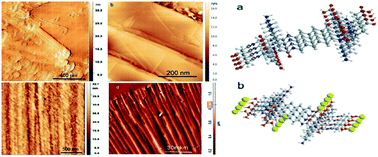Features of the crystallization of multicomponent solutions: a dipeptide, its salt and potassium carbonate†
Abstract
For the first time, all stages of non-equilibrium crystallization of multicomponent peptide solutions have been studied in detail, starting with the formation of colloidal dispersions and ending with the growth of solid layers. The crystallization of a short dipeptide (DPT-0), its potassium salt (DPT-1) and K2CO3 in aqueous solutions was studied. DPT-0 and DPT-1 form colloidal solutions in which the particle size depends on the charge of the DPT molecule. In comparison with DPT-0, in the case of DPT-1 the particle size doubles and the coalescence of colloidal particles begins with the formation of micron-sized aggregates. When DPT solutions are applied to solid surfaces, colloidal particles disintegrate. With an excess of K2CO3, its stratification at the droplet border is observed. Depending on the charge of the DPT molecule (neutral or anion), not only the surface morphology of layers but also their electron energy and chemical structures change. In DPT-1 layers on gold and graphite, unlike DPT-0, in addition to bipolar resistive switching and residual polarization the sharp negative jumps of tunneling current appear. The reason for this are K+ ions, which create one-electron traps in the near-electrode region. Of particular interest is the opposite direction of the residual polarization vector of DPT-1 layers on graphite and gold. The molecular packaging, the structure and morphology of the growing layers are determined by the nature of the substrate–layer interfaces, which create a template for layer growth. The adsorption of DPT-1 leads to the destruction of salt bridges and a change in the ratio of α-helix to β-sheet structures. On gold all the layers of DPTs and K2CO3 are composed of globules, the sizes of which are 40–100 nm. On the graphite surface, islands are observed with a height of 1–2 monolayers and protofibrils with a width of 17–20 nm and a height of 1–2 nm. With increasing layer thickness, protofibrils form mature fibrils. An analysis of all the results obtained shows that they are determined by the nature of the conformational changes of peptide molecules in adsorption layers on different substrates, and the structure of the peptide solid layers laid already at the stage of its adsorption. The various models of the adsorption of DPT on different substrates and the possibility of practical use of the results are considered.

- This article is part of the themed collection: Crystal Growth


 Please wait while we load your content...
Please wait while we load your content...